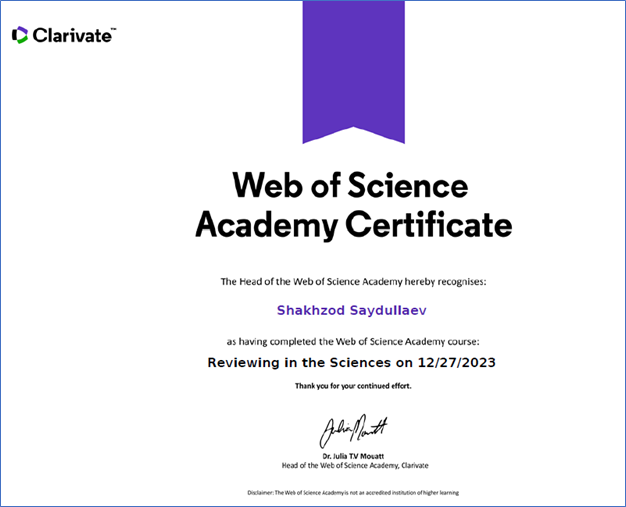Examining the total factor productivity changing patterns in Kazakhstan: An input-output analysis
DOI:
https://doi.org/10.15549/jeecar.v9i6.958Keywords:
Total Factor Productivity, value added, extractive sectors, human capital, Kazakhstan.Abstract
The interconnectedness of sectors displays the demand for inputs and supply as a level of output in any economy. This paper addresses the Total Factor Productivity (TFP) in Kazakhstan sectors by using input-output tables during 2012-2017. The change in total sectoral production was separated into two parts: the changes in technical coefficients of intermediate inputs and the change in value-added inputs, respectively. The main findings have identified a changing pattern in sectoral performance. At the same time, the result justified that various sectors such as; petroleum, manufacturing, construction, and food processing sectors have shown increased productivity. The country highly depends on extractive industries but still has better manufacturing value-added performance. The study suggests that to combat challenges like COVID-19 and climate change, it is vital to develop human capital and diversity. With diversification and innovative measures, an economy can attain sustainable economic growth in the long term.
References
Aliev, T.M. (2015). Kazakhstan, Resource Curse or Dutch Disease? Problems of Economic Transition. 57(10), 1-28, DOI: 10.1080/10611991.2014.1119558 DOI: https://doi.org/10.1080/10611991.2014.1119558
Asian Development Bank (2020). Economic indicators for South and Central Asia Input–Output Tables. http://dx.doi.org/10.22617/TCS200240-2 DOI: https://doi.org/10.22617/TCS200240-2
Aubakirova, T. (2015). On the Republic of Kazakhstan's New Industrialization, Problems of Economic Transition. 57(10), 42-58, DOI: 10.1080/10611991.2014.1119562 DOI: https://doi.org/10.1080/10611991.2014.1119562
Azomahou, T.T., Ndung’u, N., & Ouédraogo, M. (2021). Coping with a dual shock: The economic effects of COVID-19 and oil price crises on African economies. Resources Policy, 72, 102093. DOI: https://doi.org/10.1016/j.resourpol.2021.102093
Bekhet, H.A. (2012). Assessing development efficiency in Malaysian economy: I-O approach’, International Journal of Economics and Business Research. 4(3), 297–325. DOI: https://doi.org/10.1504/IJEBR.2012.046823
Bekhet, H.A. (2013). Assessing structural changes in the Malaysian economy: I-O approach. Economic Modelling, 30, 126–135. DOI: https://doi.org/10.1016/j.econmod.2012.09.014
Bjerkholt, O., & Kurz, H.D. (2006) Introduction: the History of Input–Output Analysis, Leontief's Path and Alternative Tracks. Economic Systems Research, 18(4), 331-333, DOI: 10.1080/09535310601020850 DOI: https://doi.org/10.1080/09535310601020850
BTI Transformation Index (2020). Available at: https://bti-project.org/en/reports/country-dashboard/KAZ
Chen, C., Shi, Y., Zhang, P., & Ding, C. (2021). A Cross-Country Comparison of Fiscal Policy Responses to the COVID-19 Global Pandemic. Journal of Comparative Policy Analysis: Research and Practice, 23(2), 262-273, DOI: 10.1080/13876988.2021.1878885 DOI: https://doi.org/10.1080/13876988.2021.1878885
Chirikure, S. (2014). ‘Where angels fear to tread’: ethics, commercial archaeology, and extractive industries in southern Africa, Azania. Archaeological Research in Africa, 49(2), 218-231, DOI: 10.1080/0067270X.2014.909166 DOI: https://doi.org/10.1080/0067270X.2014.909166
Deng, M. (2022). China economic performance and natural resources commodity prices volatility: Evidence from China in COVID-19. Resources Policy, 75, 102525. DOI: https://doi.org/10.1016/j.resourpol.2021.102525
FRED (2022). University of Groningen and University of California, Davis, retrieved from FRED, Federal Reserve Bank of St. Louis; https://fred.stlouisfed.org/searchresults?st=kazakhstan
Graulau, J. (2019). The Underground Wealth of Nations On the Capitalist Origins of Silver Mining, A.D. 1150-1450. Yale University Press, ISBN: 9780300218220. DOI: https://doi.org/10.12987/yale/9780300218220.001.0001
Gregori, T., & Pietroforte, R. (2015). An input-output analysis of the construction sector in emerging markets. Construction Management and Economics, 33(2), 134-145, DOI: 10.1080/01446193.2015.1021704 DOI: https://doi.org/10.1080/01446193.2015.1021704
Guan, L., Zhang, W., Ahmed, F., & Naqvi, B. (2021). The volatility of natural resource prices and its impact on the economic growth for natural resource-dependent economies: A comparison of oil and gold dependent economies. Resources Policy, 72, 102125. DOI: https://doi.org/10.1016/j.resourpol.2021.102125
Haddad, E.A., Perobelli, F.S., Araújo, I.F., & Bugarin, K.S.S. (2021). Structural propagation of pandemic shocks: an input–output analysis of the economic costs of COVID-19. Spatial Economic Analysis, 16(3), 252-270, DOI: 10.1080/17421772.2020.1844284 DOI: https://doi.org/10.1080/17421772.2020.1844284
Heintz, J., Staab, S., & Turquet, L. (2021). Don't Let Another Crisis Go to Waste: The COVID-19 Pandemic and the Imperative for a Paradigm shift. Feminist Economics, 27(1-2), 470-485, DOI: 10.1080/13545701.2020.1867762 DOI: https://doi.org/10.1080/13545701.2020.1867762
Hulten, C.R. (1975). Technical Change and the Reproducibility of Capital. The American Economic Review, 65 (5), 956-965.
Hulten, C.R. (1978). Growth accounting with intermediate inputs. Review of Economic Studies, 45(3), 511–518. DOI: https://doi.org/10.2307/2297252
Junisbai, A.K. (2014). The Determinants of Economic System Legitimacy in Kazakhstan. Europe-Asia Studies, 66(8), 1234-252, DOI: 10.1080/09668136.2014.941701 DOI: https://doi.org/10.1080/09668136.2014.941701
Karenov, R. (2015). The Productivity 2020 Program in the Context of the New Industrialization of the Republic of Kazakhstan. Problems of Economic Transition, 57(10), 29-41, DOI: 10.1080/10611991.2014.1119559 DOI: https://doi.org/10.1080/10611991.2014.1119559
Kofoworola, O.F., & Gheewala, S.H. (2008). Environmental Life Cycle Assessment of a Commercial Office Building in Thailand. International Journal of Life Cycle Assessment, 13, 498-511. DOI: https://doi.org/10.1007/s11367-008-0012-1
Luong, P.J., & Weinthal, E. (2001). Prelude to the Resource Curse: Explaining Oil and Gas Development Strategies in the Soviet Successor States and Beyond, Comparative Political Studies, 34(4), 367-399. DOI: https://doi.org/10.1177/0010414001034004002
Mahmood, M., & Mostafa, G. (2018). Kazakhstan–BRICS Economic Cooperation: Exploring the Possibilities, Journal of Balkan and Near Eastern Studies, 20(2), 148-164, DOI: 10.1080/19448953.2018.1379750 DOI: https://doi.org/10.1080/19448953.2018.1379750
Miller, R.E., Blair, P.D. (2009). Input-Output Analysis: Foundations and Extensions, Cambridge University Press, 2nd ed., New York, USA. DOI: https://doi.org/10.1017/CBO9780511626982
Asian Development database (ADB, 2022). Kazakhstan: Input-Output Economic Indicators. Available at: https://data.adb.org/dataset/kazakhstan-input-output-economic-indicators
Omelicheva, M.Y., & Markowitz, L.P. (2021). COVID-19 in Central Asia: (De-)Securitization of a Health Crisis?. Problems of Post-Communism, DOI: 10.1080/10758216.2021.2009349 DOI: https://doi.org/10.1080/10758216.2021.2009349
Kofoworola, O.F., & Shabbir Gheewala, S. (2008). An input–output analysis of Thailand's construction sector. Construction Management and Economics, 26(11), 1227-1240, DOI: 10.1080/01446190802425560 DOI: https://doi.org/10.1080/01446190802425560
Petrick, M., Oshakbayev, D., Taitukova, R., & Djanibekov, N. (2017). The return of the regulator: Kazakhstan’s cotton sector reforms since independence. Central Asian Survey, 36(4), 430-452, DOI: 10.1080/02634937.2017.1392928 DOI: https://doi.org/10.1080/02634937.2017.1392928
Reis, H., & Rua, A. (2009). An Input–Output Analysis: Linkages versus Leakages. International Economic Journal, 23:4, 527-544, DOI: 10.1080/10168730903372323 DOI: https://doi.org/10.1080/10168730903372323
Ren, O., Gu, G., Zhou, Y., & Zhang, Z. (2022). Research on the economic effect of employment structure change in heterogeneous regions: evidence from resource-based cities in China. Economic Research-Ekonomska Istraživanja, DOI: 10.1080/1331677X.2022.2048199 DOI: https://doi.org/10.1080/1331677X.2022.2048199
Sadik-Zada, E.R. (2021). Addressing the growth and employment effects of the extractive industries: white and black box illustrations from Kazakhstan. Post-Communist Economies, 33(4), 402-434, DOI: 10.1080/14631377.2020.1745557 DOI: https://doi.org/10.1080/14631377.2020.1745557
Scholvin, S., Breul, M., & Diez, J.R. (2021). A magic formula for economic development? Global market integration and spatial polarization in extractive industries. Area Development and Policy, 6(3), 337-346, DOI: 10.1080/23792949.2020.1823237 DOI: https://doi.org/10.1080/23792949.2020.1823237
Shahbaz, M., Bhattacharya, M., & Mahalik, M.K. (2017). Finance and income inequality in Kazakhstan: evidence since transition with policy suggestions. Applied Economics, 49(52), 5337-5351, DOI: 10.1080/00036846.2017.1305095 DOI: https://doi.org/10.1080/00036846.2017.1305095
Singh, J.T.N. (2014). Towards Post-neoliberal Resource Politics? The International Political Economy (IPE) of Oil and Copper in Brazil and Chile. New Political Economy, 19(3), 329-358, DOI: 10.1080/13563467.2013.779649 DOI: https://doi.org/10.1080/13563467.2013.779649
Tamba, J.G. (2017). Crude oil production and economic growth: Evidence from Cameroon, Energy Sources. Part B: Economics, Planning, and Policy, 12(3), 275-281, DOI: 10.1080/15567249.2015.1101511 DOI: https://doi.org/10.1080/15567249.2015.1101511
Turganbayev, Y. (2016). Regional convergence in Kazakhstan. Post-Communist Economies, 28(3), 314-334, DOI: 10.1080/14631377.2016.1204745 DOI: https://doi.org/10.1080/14631377.2016.1204745
Turganbayev, Y. (2017). Total factor productivity convergence across the Kazakh regions. Post-Communist Economies, 29(2), 182-197, DOI: 10.1080/14631377.2016.1267975 DOI: https://doi.org/10.1080/14631377.2016.1267975
Turganbayev, Y., & Diener, A.C. (2018). Kazakhstan’s evolving regional economic policy: assessing strategies of post-socialist development. Eurasian Geography and Economics, 59(5-6), 657-684, DOI: 10.1080/15387216.2019.1586559 DOI: https://doi.org/10.1080/15387216.2019.1586559
World Bank (2022). Kazakhstan Economic Update: Economic Recovery during Challenging Times (English). Kazakhstan Economic Update Washington, D.C.: World Bank: Group. http://documents.worldbank.org/curated/en/566741640158785669/
Zhou, H., Li, D., Mustafa, F., & Altuntas, M. (2022). Natural resources volatility and South Asian economies: Evaluating the role of COVID-19. Resources Policy, 75, 102524. DOI: https://doi.org/10.1016/j.resourpol.2021.102524
Downloads
Published
How to Cite
Issue
Section
License
The JEECAR journal allows the author(s) to hold the copyright and publishing rights of their own manuscript without restrictions.
This journal applies the Creative Attribution Common License to works we publish, and allows reuse and remixing of its content, in accordance with a CC-BY 4.0 license.
Authors are free to: Share — copy and redistribute the material in any medium or format and Adapt — remix, transform, and build upon the material for any purpose, even commercially.
Under the following terms: Attribution — You must give appropriate credit, provide a link to the license, and indicate if changes were made. You may do so in any reasonable manner, but not in any way that suggests the licensor endorses you or your use.
No additional restrictions — The author may not apply legal terms or technological measures that legally restrict others from doing anything the license permits.
The JEECAR Journal is committed to the editorial principles of all aspects of publication ethics and publication malpractice as assigned by the Committee on Public Ethics.












